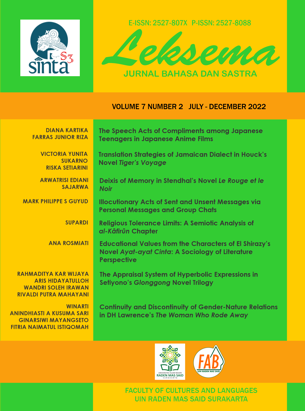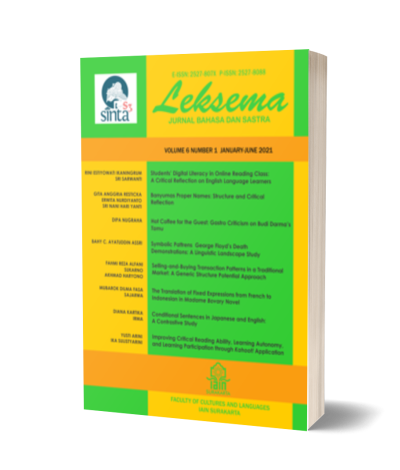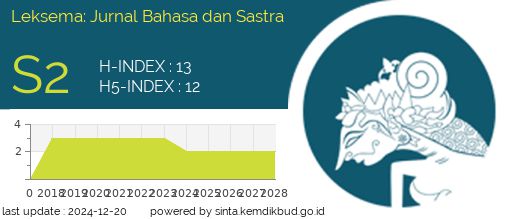RELIGIOUS TOLERANCE LIMITS: A SEMIOTIC LINGUISTIC ANALYSIS OF AL-KĀFIRŪN CHAPTER
DOI:
https://doi.org/10.22515/ljbs.v7i2.5580Keywords:
religious tolerance, Qur’anic teachings, semiotic linguisticsAbstract
This article aims to find the demarcation limit lines of religious tolerance from al-Kāfirūn chapter of the Holy Qur’an and respond to some issues developing in Indonesian. This study is based on an exploratory analysis of semiotic linguistic meanings of the chapter with an intention to respond to Indonesian Issues regarding the practices of religious greeting of the opening public speech, congratulating other religious celebrations, and singing performance of muslim students’ in a church as cases in point. This study found that the religious tolerance limits are ‘the belief’ and ‘the rituals’. Three activities are considered to go beyond the religious tolerance limits drawn from the chapter being studied, namely: (1) compromising religious belief, (2) mixing religious ritual activities, and (3) imposing religion on others. These three are, among others, the measurement of the activities considered tolerance or intolerance.
Downloads
References
Abdul Muthaliff et al. 2016. “Religious Harmony and Peaceful Co-existence”. Al’Abqari: Journal of Islamic Social Sciences and Humanities 7 (1): 47-62
Arkoun, Mohammed. 2000. Essais sur la Pensée Islamique. Bandung: Pustaka Hidayatullah
Asad, Muhammad. 2000. The Message of the Qur’an. Bandung: Mizan
Bakar, Abu. 2015. “Konsep Toleransi dan Kebebasan Beragama”. Toleransi: Media Komunikasi Umat Beragama. 7 (2): 123-131
Damasyqi, Imaduddin Abi Fida' Ismail Ibn Umar Ibn Katsir Al-. 1992. Tafsir Ibnu Kathir. Beirut: Maktabah al-Nur al-‘Ilmiyyah
Jamaludin, Muhamad, Nur Aini & Ahmad Sihabul Millah. 2021. “Mitologi dalam QS. Al-Kāfirūn Perspektif Semiotika Roland Barthes”. Jalsah: Jurnal al-Quran and as Sunnah Studies. 1(1): 45-61
Jamrah, Suryan A. 2015 “Toleransi Antarumat Beragama: Perspektif Islam.” Jurnal Ushuluddin 23 (2): 185-200
Kamali, Muhammad Hasyim. 2020. Diversity and Pluralism: A Qur’anic Perspective. ICR Jurnal 1 (1): https://doi.org/10.52282/icr.v1i1.12
Kanišauskas, Saulius. 2010. “Tolerance Boundaries and Cultural Egalitarianisme”. Limes 3 (1): 67-78
Mu’ti, Abdul & Ahmad Najib Burhani. 2019. “The Limits of Religious Freedom in Indonesia: Concerning the First Pillar Ketuhanan Yang Maha Esa of Pancasila”. Indonesian Journal of Islam and Muslims Societies 9 (1): 111-134
Muharam, Ricky Santoso. 2020. “Membangun Toleransi Umat Beragama di Indonesia Berdasarkan Konsep Deklarasi Kairo”. Jurnal HAM 11(2)
Muharom, Fauzi. 2016. “Partisipasi Kelompok Kerja Guru Pendidikan Agama Islam Sekolah Dasar (KKG PAI SD) Kabupaten Boyolali dalam Meningkatkan Kompetensi Guru PAI SD”. Nadwa: Jurnal Pendidikan Islam 10 (2)
Muslimin, Imam. 2000. “Tafsir Semantik Terhadap Surat al-Kāfirūn”. Lingua: Jurnal Bahasa dan Sastra. Malang: UIN Malang
Qutub, Sayyid. (n.d.) Fi Dhilalil Quran. Cairo: Dar al Syuruq
Romly, Dimyathi & Muhammad Afifuddin. 2018. As-Syāmil fi Balaghati al-Quran Juz 3: 551-552. Surabaya: Lisanul Arabi
Shihab, Quraysh. 2003. Tafsir al-Mishbāh: Pesan, Kesan, dan Keserasian al-Qur’an. Jakarta: Lentera Hati
Ulya. 2011. “Hermeneutika Double Movement Fazlurahman: Menuju Penetapan Hukum Bervisi Etis”. Ulul Albab: Jurnal Studi Islam 12 (2): 111-127
Usman, Abur Hamdi. 2018. Does Islam Practice Tolerance? Some Notes from Quranic Perspective. Preprints 2018070366. doi: 10.20944/preprints201807.0366.v1
Wittmer. J. 2020. “Tolerance Ends Where Harm Begins: The Boundaries of Active Cultural Tolerance”. Success across Cultures. https://successacrosscultures.com/2020/05/08/ tolerance-ends-where-harm-begins-the-boundaries-of-active-cultural-tolerance/
Downloads
Published
Issue
Section
License
Copyright (c) 2022 Leksema: Jurnal Bahasa dan Sastra

This work is licensed under a Creative Commons Attribution-NonCommercial-ShareAlike 4.0 International License.
The copyright of the received article shall be assigned to the publisher of the journal. The intended copyright includes the right to publish the article in various forms (including reprints). The journal maintains the publishing rights to published articles.
In line with the license, the authors and users (readers or other researchers) are allowed to share and adapt the material only for non-commercial purposes. In addition, the material must be given appropriate credit, provided with a link to the license, and indicated if changes were made. If authors remix, transform or build upon the material, authors must distribute their contributions under the same license as the original.







